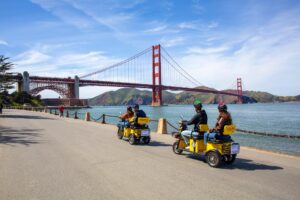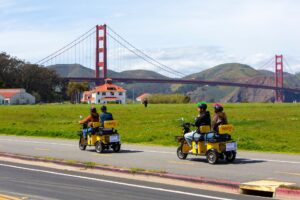Exploring the Historic Fishing Fleet at Fisherman’s Wharf
When you stroll along San Francisco’s iconic Fisherman’s Wharf, you’re not just experiencing a bustling tourist destination; you’re stepping into a rich maritime history that stretches back to the 1800s. Let’s dive into the captivating world of the historic fishing fleet at Fisherman’s Wharf, filled with intriguing facts about the original fishermen, the evolution of fishing boats, and a mouthwatering dish that’s become a San Francisco tradition.
6 Facts About the Original Fishermen of Fisherman’s Wharf
The original fishermen who called Fisherman’s Wharf home were a unique bunch, and their legacy still thrives today through their descendants. Here are some fascinating facts about these early pioneers:
- Italian Immigrant Roots: The first-generation Italian immigrants who settled in Fisherman’s Wharf knew how to do more than just fish. They were known for their singing prowess and could belt out a Verdi aria, even in the thickest fog outside the Golden Gate.
- Weather Wisdom: Forget the weather app; these fishermen had their own way of predicting the weather. If the moon was in the east, it signaled the incoming tide. In the west, it meant the tide was flowing out. A circle around the moon? Get ready for rain. And if porpoises were frolicking around the boat, that was a warning sign of impending bad weather.
- Feluccas: The fishing boats of yore, called feluccas, were constructed in a style reminiscent of the boats in their Italian homeland. These charming vessels were typically painted green and often bore the name of a patron saint on their hulls.
- Creative Commuting: When the fishermen needed a ride home, they didn’t hail a taxi. Instead, they’d throw a grappling hook into the rudder chain of passing steamers and shout back with colorful language when the crew on those steamers expressed their frustration.
- Modest Earnings: Life for these early fishermen was tough. In the early days of Fisherman’s Wharf, the average fisherman earned a meager $2 to $5 a week. To put it in perspective, a loaf of bread could be bought for less than five cents back then.
- Singing Through the Fog: In the fog-shrouded waters outside the Golden Gate, singing wasn’t just for entertainment; it was a means of communication. You couldn’t see nearby boats in the fog, but you could tell they were there by the songs of their captains.
The Evolution of Fishing Boats: From Feluccas to Diesel-Powered Craft
The fishing fleet at Fisherman’s Wharf has seen remarkable transformations over the years. Here’s a glimpse into the evolution of these seafaring vessels:
- Feluccas: The original fishing boats, feluccas, with their lateen-rigged sails and traditional design, were a common sight in San Francisco Bay. These charming green boats with patron saint names on their hulls were the hallmark of the early fishing community.
- Monterey Hull Boats: With the introduction of gasoline engines came the “second-generation” of fishing boats known as Monterey Hull boats. These small but dependable vessels made it possible to fish more days of the year, extended the range of operation, and provided power for hauling in nets and lines. They were like the Model-Ts of the sea.
- Diesel-Powered Craft: Today, a “third generation” of commercial fishing boats dominates the scene. These diesel-powered craft are larger, offer greater cruising capacity, and often feature state-of-the-art technology. They stand alongside the Monterey Hull boats, a testament to the evolution of fishing technology.
Chowin’ Down on Cioppino: A Taste of San Francisco’s Seafood Heritage
No visit to Fisherman’s Wharf is complete without indulging in a steaming bowl of Cioppino, a dish that has deep roots in this maritime community. Here’s a delicious dive into this iconic seafood stew:
- Cioppino Origins: Cioppino is a hearty seafood stew traditionally made with a medley of seafood, including fish, crab, shrimp, and sometimes even potatoes and beans. It’s cooked in a flavorful tomato-based sauce, enriched with vegetables and herbs.
- Italian-American Heritage: The dish’s origins are firmly rooted in the Italian-American fishing community of Fisherman’s Wharf. It’s a testament to the resourcefulness of these fishermen, who used the day’s catch to create a comforting and hearty stew that has since become a San Francisco tradition.
Weathering the Seas and Passing on Tradition
In the early days of Fisherman’s Wharf, the fishermen relied on nature to forecast the weather, rowed their boats in calm seas, and even hitched rides on passing steamers to get home. Despite the challenges and meager earnings, they persevered, passing down their maritime heritage to the present generation.
Today, Fisherman’s Wharf continues to be a vibrant hub of activity, thanks to the grandsons and great-grandsons of those early fishermen. It’s a place where tradition meets modernity, where the echoes of Italian arias still linger, and where Cioppino warms the hearts of locals and visitors alike. So, the next time you’re at Fisherman’s Wharf, take a moment to appreciate the rich history and culinary delights that this iconic San Francisco destination has to offer.
Experience San Francisco’s Maritime Heritage at the Historic Fishing Fleet in Fisherman’s Wharf
Information provided by the Fisherman’s Wharf Merchants Association





